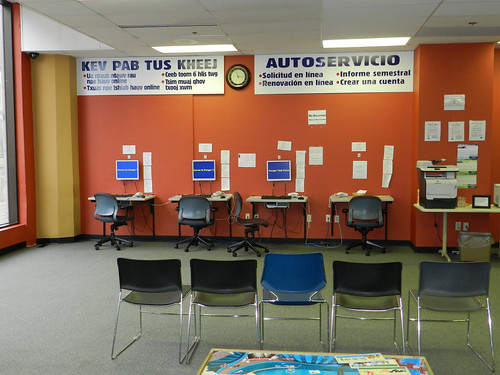
Here at USDA, we’re always looking for great ideas and best practices that improve access to our programs. Access to USDA’s SNAP Supplemental Nutrition Assistance Program (formerly the Food Stamp Program) by Hispanics/Latinos is a special concern because our data show that many low-income Latinos simply don’t apply for SNAP even though they’re eligible. Language and cultural differences, confusion and fear about immigration status of family members are very real roadblocks for many Latinos. That’s why we’re encouraged by a new and exciting social services model in Milwaukee – the Robles Center - that is reducing those barriers and empowering Latino customers. Recently I talked with Sherrie Tussler, executive director of the Hunger Task Force (HTF) in Milwaukee, to learn more.
First Sherrie gave me a brief history of the Robles Center. Established in the 1970’s, Robles was the first social services office serving Milwaukee’s predominantly Latino south side. In January 2010, the old Robles Center was closed, due to a state office consolidation. However, after a spirited petition drive and intensive advocacy by the HTF and their community partners, the Center reopened two months later – this time transformed into Milwaukee’s first-ever self-service office for SNAP application.
Today the center still serves many low-income Latinos, along with Hmong and other ethnic groups. But Robles no longer operates as a traditional welfare office, where you’d expect to see a roomful of people waiting to see their caseworkers. It’s been transformed into a modern self-service facility through an innovative partnership between the HTF and the Wisconsin Department of Health Services.
The new Robles Self Service Center is large, brightly lit and welcoming. At Robles, clients learn how to manage their own FoodShare (SNAP) cases and apply for health care (BadgerCare Plus) and child care benefits. The Center is funded 50% by USDA SNAP outreach money and 50% by the HTF. About 300 clients visit the Robles Center each month. In 2010, its first year, over 5,200 people received help.
Clients are welcomed by signs in Spanish, English and Hmong. Bilingual workers are available to show clients how to use the computer terminals and scanning stations. The Center is staffed by three HTF employees and one state merit employee. HTF staff show clients how to use the computers (many clients don’t have computers at home and lack basic computer literacy). “Our goal,” says Sherrie, “is to teach people how to take care of themselves.” If the person encounters a problem that the HTF staff can’t solve, the state employee steps in to help.

Robles staff teach clients how to report required income and other changes by using the center’s scanner, fax and copy machines. Clients can send in their verification documents like birth certificates, pay stubs and rent receipts, or check on the status of their benefits. Phones are located at each computer allowing customers to call DHS for an interview. “Although it shouldn’t seem novel,” says Sherrie Tussler, “we allow the customer to use all of the equipment independently to manage their own case. We only step in if they need help.”
The HTF also supports another predominantly Latino office about 2 ½ miles away from Robles -- UMOS (United Migrant Opportunity Services). The HTF stations three self-service computers there, as well as one employee who helps clients use the computers. UMOS offers a more traditional welfare office experience, with 14 state merit employees who conduct face to face interviews with clients.
“We have a long term goal of teaching people to take care of themselves in both locations,” says Sherrie Tussler. “If they learn how to use the computers, they won’t have to take a day off work in order to get SNAP or other benefits.” It’s all about empowerment, dignity and independence.
